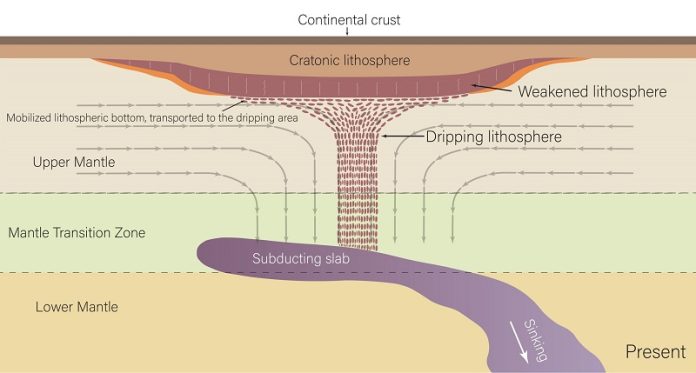
In a surprising new discovery, scientists have found that the underside of the North American continent is slowly “dripping” away—like blobs of rock melting off into the Earth’s mantle.
This strange process, called cratonic dripping, is happening deep underground and was spotted using advanced computer models and seismic data.
The discovery was made by researchers at the University of Texas at Austin and published in the journal Nature Geoscience. It’s the first time that scientists believe they’ve caught this type of geological change happening in real time.
So, what’s actually dripping?
The Earth’s continents have very old, strong base layers called cratons. These cratons are extremely stable and have lasted for billions of years.
But sometimes, parts of them can break off and sink into the Earth. That’s what’s happening now under the Midwestern United States, where parts of the North American craton appear to be thinning and slowly dripping downward.
“There could be something beneath the craton causing this,” said Junlin Hua, the lead researcher, who began the study while working as a postdoctoral fellow at UT Austin. “We believe we’ve found the cause of this thinning.”
The main suspect? A long-lost tectonic plate called the Farallon Plate, which has been sliding underneath North America for nearly 200 million years. Even though it now lies about 600 kilometers below the surface, it seems to still be affecting the continent from below.
The researchers believe the Farallon Plate is changing the flow of hot rock in the mantle, pushing against the base of the craton and weakening it. This slow movement may cause parts of the craton to break off and sink—like thick drops of syrup falling from a spoon.
There’s no need to panic, though. This process is incredibly slow and won’t cause any sudden changes to the land above. But for scientists who study how continents form and change, this discovery is a big deal.
“This helps us understand how continents are built, broken, and recycled back into the Earth,” said co-author Thorsten Becker, a geophysics professor at UT Austin.
The team used a powerful computer model, based on seismic data from the EarthScope project, to “see” the dripping in more detail than ever before. The model showed that the dripping only happens when the Farallon Plate is present. When it’s removed from the model, the dripping stops.
“This looks like the real thing,” Becker said. “We’re getting a new look at how the inside of Earth works.”
So while the Earth beneath our feet seems solid and still, there’s a slow-motion story playing out deep below—and now, scientists are finally watching it unfold.
Source: University of Texas at Austin.



